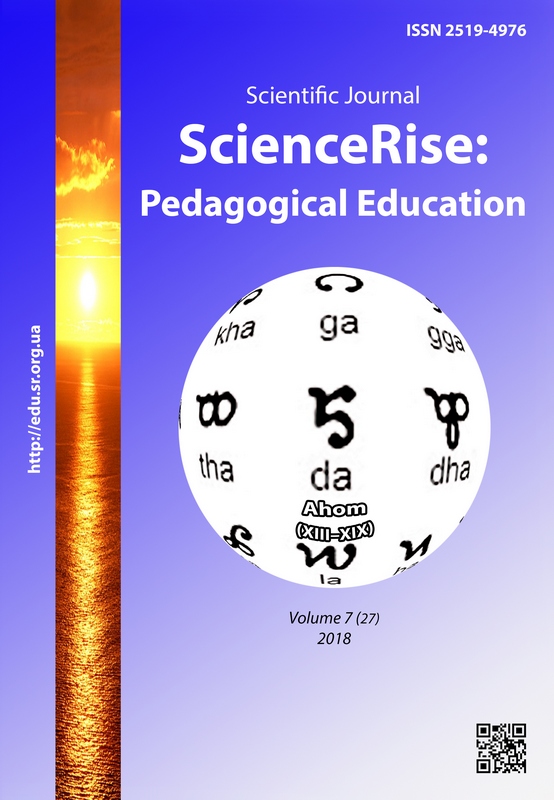Use of edutainment in the methodology of chemistry education in school
DOI:
https://doi.org/10.15587/2519-4984.2018.153375Keywords:
edutainment technologies, chemistry teaching methodology, school chemistry course, mobile learningAbstract
The article is aimed at studying the possibility of using educational technologies edutainment in the school course of chemistry. The term edutainment was obtained by merging two English words – "education" and "entertainment". One of the benefits of technology utilization when learning the school's chemistry course is that students can learn new cognitive skills. For example, develop logical thinking and spatial feelings, learn to collaborate, preparing them for further learning and solving other problem situations. The article presents an analysis of some mobile applications and computer programs that can be used in a school chemistry course. The main characteristics of the programs are evaluated. The advantages of the problem and perspectives of their use were established and the analysis of the school curriculum on the chemistry course of 7th grade was carried out on the example of the textbook "Chemistry of the 7th grade", author G.А. Lashevskaya. The article presents the main themes of the 7th grade in the textbook, which can be supplemented by the technology of edutainment.
In the study of chemistry in 7th grade, it will be advisable to use Thoisoi and Smart Learning for all video tutorials. In 7th grade, students first encounter chemistry as a science, the use of video collections will allow students to formulate ideas about the structure of the molecule and develop abstract thinking in them. Thus, the article describes that the use of the game MarsHimProm in the study of chemistry can become a test for solving complex urgent problems or projects that they can perceive or reject. The MEL Chemistry: 3D app will provide students with the tools and resources needed to understand and solve the problem, and allow students to explore, experiment, construct, communicate, and reflect on what they are doing – that is, to learn from their personal experiences.
In the context of this theory, learning using educational technology involves solving problems through the student's choice of how to solve it. The acquired experience is enriched with reflection, becoming deeper
References
- Dyakonova, O. O. (2012). Ponyatie “edyuteynment” v zarubezhnoy i otechestvennoy pedagogike [The term "edutainment" in foreign and domestic pedagogy]. Siberian Pedagogical Journal, 6, 182–185. Available at: https://cyberleninka.ru/article/n/ponyatie-edyuteynment-v-zarubezhnoy-i-otechestvennoy-pedagogike
- Bukatov, V. M. (2014). Interaktivnyie tehnologii obucheniya: poyavlenie, harakteristiki, priznaki i funktsii [Interactive learning technologies: appearance, characteristics, signs and functions]. New in psychological and pedagogical research, 4, 73–80. Available at: https://elibrary.ru/item.asp?id=22957398
- Dempsey, J. V., Haynes, L. L., Lucassen, B. A., Casey, M. S. (2002). Forty Simple Computer Games and What They Could Mean to Educators. Simulation & Gaming, 33 (2), 157–168. doi: https://doi.org/10.1177/1046878102332003
- Bilous, V. (2017). Mobile applications for teaching mathematics as a means to enhance motivation for junior high school students. Open educational e-environment of modern university, 3, 303–309. doi: https://doi.org/10.28925/2414-0325.2017.3.30309
- Gorbatyuk, R. M., Tulashvvili, Yu. Y (2013). Mobilne navchannya yak nova tehnologsya vischoyi osviti [Mobile learning as a new technology of higher education]. Scientific Herald of Uzhhorod National University, 27, 31–34. Available at: http://nbuv.gov.ua/UJRN/Nvuuped_2013_27_10
- Jonassen, D. H. (1999). Designing Constructivist Learning Environments. Instructional Design Theories and Models: A New Paradigm of Instructional Theory. Lawrence Erlbaum Associates,. 215–239.
- Malone, T. W., Lepper, M. (1987). Making Learning Fun: A Taxonomy of Intrinsic Motivations for Learning. Hilsdale, NJ: Erlbaum, 223–253. Available at: https://www.researchgate.net/publication/238687478_Making_learning_fun_A_taxonomy_of_intrinsic_motivations_for_learning
- Krutiy, K (2017). Edyuteynment: navchannya yak rozvaga [Edutainment: learning as fun]. Preschool education, 1. Available at: http://ukrdeti.com/edyutejnment-navchannya-yak-rozvaga/
- Dendev, B. (2013). Informatsionnyie i kommunikatsionnyie tehnologii v obrazovanii [Information and communication technologies in education]. Moscow: IITE UNESCO, 320. Available at: https://www.twirpx.com/file/1511035/
- Pasichnyk, M. V., Garkovich, O. L., Yuschishina, G. M. (2018). Metodika navchannya himii [Methodology of teaching chemistry]. Mykolaiv, 417.
Downloads
Published
How to Cite
Issue
Section
License
Copyright (c) 2018 Maria Pasichnyk

This work is licensed under a Creative Commons Attribution 4.0 International License.
Our journal abides by the Creative Commons CC BY copyright rights and permissions for open access journals.
Authors, who are published in this journal, agree to the following conditions:
1. The authors reserve the right to authorship of the work and pass the first publication right of this work to the journal under the terms of a Creative Commons CC BY, which allows others to freely distribute the published research with the obligatory reference to the authors of the original work and the first publication of the work in this journal.
2. The authors have the right to conclude separate supplement agreements that relate to non-exclusive work distribution in the form in which it has been published by the journal (for example, to upload the work to the online storage of the journal or publish it as part of a monograph), provided that the reference to the first publication of the work in this journal is included.








